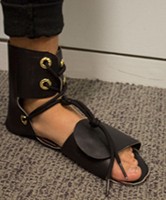
Experimental Fashions to Help in Fight Against Degenerative Joint and Muscle Disease
To raise awareness about how design and fashion can potentially make a difference, 28 University of Cincinnati fashion, graphic communication and industrial design juniors recently created experimental garments designed especially to help those with Ehlers-Danos syndrome (EDS).
EDS is a degenerative joint and muscle disease, and those with the congenital disorder often require support for weakened joints, muscles and ligaments.
The studio course was led by Margaret Voelker-Ferrier, professor of fashion design in UCs College of Design, Architecture, Art, and Planning (DAAP). She explains that the project began when she was asked by a friend who works as a physical therapist to develop garments that would both provided the needed functional support for someone with EDS, while also providing aesthetic appeal.
I created some garments and presented them at an international conference related to EDS. That conference allowed me to make some contacts with those who cater to the needs of those with EDS. One thing led to another, and this design studio where students could take the same journey I had in learning about the disease and considering how design could make a difference to a specific community began. Weve had a lot of support. Those living with EDS and have come and talked to our class. Medical professionals have done so as well, and Velcro Industries provided us with some supplies, adds Voelker-Ferrier.
While there are no specific plans to market any of the garments produced in the fall term collaborative studio, Voelker-Ferrier hopes that the DAAP students in the course will continue to seek out opportunities to employ design as a tool to resolve challenging problems.

Experimental design concept for those with EDS.
Fashion design junior Kirsten Rissover, 21, of Amberley Village, Ohio, says, Were excited to do something with such a challenging purpose. Its not only to help those with EDS, who want to feel good about what they wear while having the function they need. This challenges our own creativity.
Rissover and three partners have worked to create garments that provide soft, flowing lines in terms of visual aesthetics while also providing options for customizable support beneath the garments exteriors.
For instance, she developed a wrap dress, wrap tank top and a maxi dress, each with a hidden, easy-to-use and adjust joint, skin and muscle support system. That bracing system began with a bandeau (not unlike a sports bra) with a zipper closure at the front, since most people with EDS have difficulty with putting on garments that must go over the head. That bandeau is complemented by an adjustable brace strap of elastic that crosses the torso in the front just below the shoulders and then crates a figure eight across the back before connecting to a belt. The belt portion of the brace system has Velcro closures so that the support tension needed can be adjusted easily and quickly.
States Rissover, Thus, my garments look light, draped and flowing but encourage and make for easier posture support at the same time. Its something we want to make easy and comfortable while providing the control necessary because this is something someone with EDS would have to wear everyday. So, for instance, my brace system can be worn in full or just a portion (shoulder, back or waist) could be worn depending on the needs of any particular day.
Others in her group worked to create a jacket with elbow support and slacks with hip support.

Experimental design concept for those with EDS.
Industrial design student Luke Hydrick, 21, of Tulsa, Okla., focused his efforts on a daily-use, washable, aesthetically appealing write brace that would both provide support and prevent those with EDS from overextending the joint.
He explains that brace is not meant to immobilize the wrist as its not intended to heal an injury. In fact, support with movement is the goal since continued use of the muscles and joints are necessary to maintain strength levels.
My goal is to prevent hyperextension of the wrist, that the brace will stop movement when it reaches a certain degree but to still have movement. At the same time, I want to create a brace that is aesthetically appealing, with an understated coolness factor, he adds.
Hydrick explains, For me, the best part of the project is that Im doing something directly related to social change. It has the genuine goal of helping people and improving their quality of life.
Related Stories
University of Cincinnati celebrates DAAP's class of 2024:...
April 27, 2024
Discover the achievements of the University of Cincinnati's College of Design, Architecture, Art, and Planning's Class of 2024 as they graduate into the alumni family, showcasing exceptional talent and innovation. From prestigious awards to prominent job offers, these graduates exemplify the transformative power of creativity and dedication in shaping tomorrow's leaders.
OTR mural centerpiece of 'big' celebration of UC alumni
April 26, 2024
New downtown artwork salutes 18 alumni award recipients who personify UC’s alumni success.
UC education allowed couple to make mark on Cincinnati
April 24, 2024
As a native of Defiance, Ohio, John Deatrick, CEAS ’79, says arriving in Cincinnati to attend the University of Cincinnati in 1963 felt like landing in New York City.
